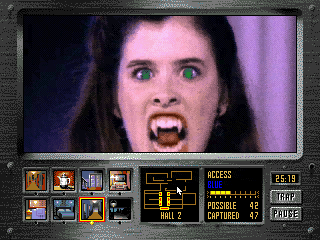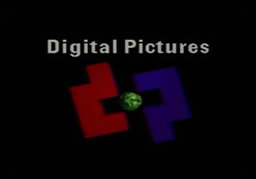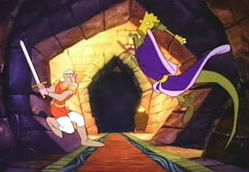Every console is remembered for something. The NES brings back memories of Super Mario Bros., the SNES conjures up thoughts of Mode 7 scaling and rotation, and the Playstation is synonymous with Final Fantasy VII. People can’t help it. Humans have a natural tendency to categorize their surroundings, and this applies to video games as well. Unfortunately, some consoles have fared better in this regard than others.
 Take the Sega CD, for example. Regardless of how many times one points out such gems as both Lunar titles, Popful Mail, Snatcher, or Eternal Champions; there’s always someone who’s quick to point out the worst it had to offer. The full motion video genre lamentably falls into this category. Mind you, I’m not instantly categorizing FMV as bad, I’m simply stating that this seems to be the general consensus when it comes to categorizing Sega CD games.
Take the Sega CD, for example. Regardless of how many times one points out such gems as both Lunar titles, Popful Mail, Snatcher, or Eternal Champions; there’s always someone who’s quick to point out the worst it had to offer. The full motion video genre lamentably falls into this category. Mind you, I’m not instantly categorizing FMV as bad, I’m simply stating that this seems to be the general consensus when it comes to categorizing Sega CD games.
Why is FMV so hated? How could something that was at one time touted as the future of the gaming industry leave such a lengthy skid mark on its history? These are some interesting questions, and to answer them, one must first look at the technology, and how it came to overtake Sega’s 16-bit add-on.
A Misunderstood Technology?
According to computerhope.com, Full motion video is defined as the following:
Abbreviated as FMV, Full motion video is a computer system that is capable of displaying full video images and sound on a computer. Depending upon the compression being used by the computer and the computer hardware the frames per second can vary. Computers not capable of displaying at least 24fps will notice the video being choppy.
One must pay great attention to that last part. Compression and a decent frame rate were key to making the video presentable, something the Sega CD and TG-16 CD weren’t very capable of. Everyone knows of the problems the Genesis had with its limited color palate, which was an issue that was never truly remedied. New shading techniques later in its life cycle would help work around the problem, but none of this was available at the Sega CD’s debut. The meager 256 colors available (64 onscreen at a time) made the video look bland and washed out. Moreover, the amount of storage and system capacity that FMV games ate up were almost too much for the meager compression codecs of the time to handle. This, along with the Sega CD’s slow speed (1X drive, 150 kbytes/sec data transfer rate) was compounded because the unit wasn’t designed with parallel processing in mind. This meant that the CPU had to constantly check if the next block of data from the CD had arrived, even when it hadn’t, most of the time. The Price? You had to wait an eternity for that next scene or level to load, and given that FMV taxed the system’s resources practically to the breaking point, it meant you waited a lot.
In essence, FMV was a technology that aspired to be more than the available hardware of the time could permit. Why was it so lauded among developers? Simple, my friend. The bandwagon effect is a powerful thing…
The Rise of FMV & the Multimedia Revolution
Full motion video as a concept was not new in 1991. It has been around since 1985, when it was first used with Hasbro’s unreleased Control-Vision console, code named NEMO, which used VHS tapes rather than ROM cartridges or 3.5 floppy disks. Several games in development for it, like Night Trap (originally titled Scene of the Crime) & Sewer Shark, eventually found their way onto the Sega CD. Even at this early stage, FMV games were proving costly to produce- $1.5 million for Night Trap and $3 million for Sewer Shark, respectively. Alternatively, FMV has its direct origins in the laser disc games of the early ’80s. Using the immense storage capacity of the new discs, costly arcade machines such as Dragon’s Lair & Space Ace gave players incredible multimedia experiences with little interaction. No one really cared at the time though, since the ability to “play” a cartoon was a novelty that had gamers firmly in its grip.
The early 1990s heralded a wave of changes to gaming. The NES was on its way out, the Genesis was finally picking up steam, and technophiles everywhere were marveling at the use of CDs as a storage medium for software. CDs had been gaining momentum in the music industry for some time, but were just starting to make headway with PCs. Users could now marvel at their new “interactive” encyclopedia, or even listen to their favorite music while working on the computer. There was finally a medium with a respectable storage size that could be obtained rather inexpensively, and people scrambled to upgrade. Thoughts soon turned to how it could best be applied on other areas.
Consoles, however, were a different story. CD-ROMs were still quite slow, and developers were wary of foregoing a cartridge release of their latest title for a CD version that would suffer from long loading times. No one really had a good grasp of how to integrate the technology into games either. The Turbo Grafx-16 was the first American console to receive a CD upgrade, and NEC mostly played it safe by only using it for enhanced audio and cut scenes. A few FMV titles were produced, like Sherlock Holmes Consulting Detective Vol. 1 & 2 and It Came from the Desert, but they weren’t given the kind of treatment enhanced sprite-based games like the Ys series was. Phillips, on the other hand, jumped in head first in 1991with their $1400 CD-i console. Heralded as one of the first “set-top boxes,” the CD-i was supposed to become the focal point of the living room experience. It was instead the laughing stock of the gaming world, a stigma forever set in stone by its horrendous butcher-job of Nintendo’s Zelda franchise, of which three games were made.
 Of course, Sega was on its way to becoming the embodiment of what was cool in gaming during the early ’90s, and were quick to act on its hard-earned popularity. It released a CD upgrade of its own to much fanfare and high expectations. The Sega CD touched down on October 15, 1992, with five of the seven initial releases being FMV titles. Sewer Shark, Night Trap, Cobra Command, and two Make My Own Video discs (INXS & Markey Mark & the Funky Bunch) were supposed to emphasize the new system’s capabilities over rival Nintendo’s fledgling SNES. The Sega CD also came with an FMV pack-in: a port of the TG-16 CD game Sherlock Homes: Consulting Detective Vol.1. Not a very appealing line up for a $400 add-on, but it still sold respectably in all territories, despite some launch problems in the U. K.
Of course, Sega was on its way to becoming the embodiment of what was cool in gaming during the early ’90s, and were quick to act on its hard-earned popularity. It released a CD upgrade of its own to much fanfare and high expectations. The Sega CD touched down on October 15, 1992, with five of the seven initial releases being FMV titles. Sewer Shark, Night Trap, Cobra Command, and two Make My Own Video discs (INXS & Markey Mark & the Funky Bunch) were supposed to emphasize the new system’s capabilities over rival Nintendo’s fledgling SNES. The Sega CD also came with an FMV pack-in: a port of the TG-16 CD game Sherlock Homes: Consulting Detective Vol.1. Not a very appealing line up for a $400 add-on, but it still sold respectably in all territories, despite some launch problems in the U. K.
It was at this time that Sega inked a deal with Digital Pictures, a new software house that specialized in FMV games. Firmly entrenched in the ideal that FMV was the wave of the future, Sega and Digital Pictures threw all their weight and money behind the genre. What was lacking in gameplay, most certainly wasn’t lacking in development costs. Ground Zero Texas, for example, cost a whopping $3 million to make, a hefty sum for the time. Star power was also brought in to prop up the new format. Different Strokes actress Dana Plato received her now-famous role in Night Trap, and Sega’s Prize Fighter was directed by Ron Stein, the fight coordinator for cinema classics Rocky and Raging Bull. This might have seemed like a good idea at the time, but what the company refused to understand was that gamers were beginning to see through the novelty that was FMV. They wanted more, and ironically enough, it would be Sega that would give them what they wanted. Even so, the company was still spending money hand over fist to make the Sega CD a success through its FMV library, and by doing so, essentially dug the console’s grave.
The Fall of FMV
There are many theories as to exactly why the Sega CD failed. Which was the fatal blow? That depends on who you ask. Regardless, there are a series of factors involving FMV games that cannot be denied as part and parcel of the unit’s death. The sad thing is that almost all of them were avoidable, but Sega’s narrow mindedness and tunnel vision business plan prevented it from seeing the writing on the wall.
- There wasn’t enough gameplay: This is probably the most glaring culprit. Pressing a button and watching what happened next simply didn’t appeal to the majority of gamers. They expected advancements in technology to immerse them more than ever into their games, not shut them out almost entirely. Most parts were simply trial and error: if you died from moving left, press right next time and move on. Furthermore, there wasn’t any replay value to be had in many of the games. After you had beaten it, what was next?
- Too many FMV games came out too soon: When the Sega CD launched, 60% of its initial library was composed of FMV games. Fans of the genre were in heaven, no doubt, but those who favored sports, shmups, or the ever-popular platformer were out of luck for several months after the system’s debut. Where was Sonic? Shinobi? Phantasy Star? Sega promised that many of its famous franchises would appear, but little by little all the games disappeared from the upcoming releases list (with the exception of Sonic, of course).
- FMV games were too costly to produce: Look at the figures for the titles mentioned above. $3 million may not seem like much today, with EA and Square boasting Hollywood-level budgets on their biggest titles, but back in 1992 it was something worth noting. When you take into account the fact that the hardware was new and untested, it becomes apparent that Sega was taking quite a risk. The FMV debacle proved to be another chink in the company’s armor, and it took a bath with the fallout.
- FMV games received too much negative press: Championed by such companies as the now-defunct Digital Pictures, the FMV genre saw a bunch of releases that quickly clogged retailers and drew attention away from more deserving titles through undesired controversy, like the senate hearings regarding Night Trap. It is interesting to note that at a time when Sega was pushing its Sega CD as the most powerful console on the planet and a must-buy item for Genesis owners, four of its FMV games filled out Entertainment Weekly‘s top-ten list of most violent games in 1994. Such attention caused a backlash that, along with the growing awareness among gamers of the lack of gameplay FMV games had, began the downward spiral that eventually led to the Sega CD’s death in 1995.
- FMV games came out at the worst possible time: Just when Sega began touting its Sega CD FMV titles, it was also courting General Electric Aerospace (makers of NASA’s 3D simulators in the 1960s) about creating a new arcade board with powerful 3D capabilities. The result? The now-famous Model 1 board, which spawned such classics as Virtua Fighter, Star Wars Arcade, and Virtua Racing. How then, could FMV ever compete against full 3D? As if gamers weren’t complaining enough, the new technology made the grainy, dark video look downright archaic by comparison. Developers at the time obviously saw what was coming, and they attempted to push the existing hardware as far as possible. The Sega CD began sporting games with more rotation and even flat-shaded polygons, and the press jumped at the inevitable rise of 3D gaming as the next big thing, leaving FMV behind. Gamers knew right away which one they wanted. Place Silpheed next to Sewer Shark and imagine which would look more appealing back in 1993 if you don’t believe me. The appearance of Virtua Fighter on the scene in 1993 was the last nail in the coffin for the embattled FMV industry.
Effects Still Felt Today
 Within a period of less than five years, the marvels of the CD format were replaced in gamer’s minds with horrible images of grainy B-grade cut scenes that almost played themselves, and a limited and unappealing library of games. The FMV phenomenon had ended almost as quickly as it had began, and the genre was reduced to what many gamers believed should have been its role from the start: cut scenes that furthered a game’s storyline rather than play it out. FMV has mostly been replaced by CG and in-game cut scenes, but it still pops up occasionally. The memory fades as time passes, but those who lived and played during the 16-bit era remember what all the hoopla was about. FMV came and went, and left quite an impression on the industry. Perhaps if its use had been handled better, it wouldn’t carry the negativity it does today, a negativity that helped sink the shiny new ship that was the Sega CD.
Within a period of less than five years, the marvels of the CD format were replaced in gamer’s minds with horrible images of grainy B-grade cut scenes that almost played themselves, and a limited and unappealing library of games. The FMV phenomenon had ended almost as quickly as it had began, and the genre was reduced to what many gamers believed should have been its role from the start: cut scenes that furthered a game’s storyline rather than play it out. FMV has mostly been replaced by CG and in-game cut scenes, but it still pops up occasionally. The memory fades as time passes, but those who lived and played during the 16-bit era remember what all the hoopla was about. FMV came and went, and left quite an impression on the industry. Perhaps if its use had been handled better, it wouldn’t carry the negativity it does today, a negativity that helped sink the shiny new ship that was the Sega CD.
Sources
- Adams, Ernest. Hardware Designers- Talk to Us! Gamasutra.com. October 22, 2003.
- Boyad, Toby. Model 1 Hardware Info. System16. 2005.
- Definition: “Full-motion video.” Computerhope. 2005.
- Gamespy Staff. The Multimedia Revolution. Gamespy. June 9-13, 2003.
- Gamespy Staff. VHS: The Future of Video Gaming. Gamespy. June 9-13, 2003.
- Nashawaty, Chris. Killer Games-Handout. Entertainment Weekly. March 11, 1994.
- Pettus, Sam. Sega CD: A Console too Soon. SegaBase. 2001.

I agree with this article. Most of those games are consider as horrible gaming experience. Hovewer, FMV titles like Phantasmagoria, Under a killing Moon are pretty good (Phantasmagoria 2 looks very good, can’t say the same thing about gameplay though). Those games were never released on Sega CD (I think the concole itself wasn’t capable to run games like Phantasmagoria).
I consider the FMV era as a really obscure time in gaming history. Interesting, but crappy 😛